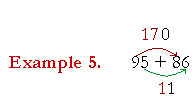|
Lesson 4 MORE ELEMENTARY ADDITIONMental calculationWe now begin the four operations of arithmetic: Addition, subtraction, multiplication, and division. The emphasis will continue to be on problems that do not require a calculator -- problems that you should not even have to write down! Mental calculation is now arithmetic of the most practical kind. In this Lesson, we will answer the following:
The student should now have mastered the elementary addition of one-digit numbers, and should be practicing the multiplication table. For, once you know that
These are not problems to write in a column. |
|||||||||||||||||||||||||||
|
|||||||||||||||||||||||||||
|
Example 1. 27 + 5 = (27 + 3) + 2 = 30 + 2 = 32 Similarly, 38 + 4 = (38 + 2) + 2 = 42 59 + 7 = (59 + 1) + 6 = 66 96 + 8 = (96 + 4) + 4 = 104 An educated person then does not have to take out a pencil, write in a
column and say, "6 plus 8 is 14 -- write 4, carry 1. etc., etc., etc." Nor does an educated person count on her fingers. Rather, an educated person knows elementary addition and therefore that 96 + 8 is not very different from 6 + 8. It must be 104. These numbers that we compose -- 10, 20, 30, 40, 50, etc. -- are called the multiples of 10. Example 2. Since 9 + 6 = 15, then
A 9 plus a 6 always gives a "15." This brings us to the practical technique for adding several numbers -- 7 + 8 + 3 + 9 + 4 Adding by endings. |
|||||||||||||||||||||||||||
|
|||||||||||||||||||||||||||
|
For example, since 8 + 4 = 12, we would know that if we add any number ending in 8 to any number ending in 4, the sum will always end in 2. 28 + 4 = 32 38 + 4 = 42 68 + 4 = 72 And so on. Each answer falls in the next decade. Similarly, since 6 + 5 = 11 then 26 + 5 = 31 46 + 5 = 51 76 + 5 = 81 They all end in 1. These are not problems to write down. Example. Add mentally -- or aloud -- from left to right.
Say only the partial sum as you come to it. Do not say,
The following is a basic technique for mental addition: |
|||||||||||||||||||||||||||
|
|||||||||||||||||||||||||||
|
435 + 461 = 896 First add the hundrededs, then the tens, then the ones. Example 1. Counting by 10's. 30 + 24 = 54
Here are other examples of mental calculations. In each case, add the numbers as you read them, from left to right. Add the 10's: 20 + 16 = 36 40 + 38 = 78 40 + 62 = 102 40 + 82 = 122 90 + 73 = 163 Example 2. 43 + 25 First add the tens, then add the ones. Say "Sixty -- 43 + 25 -- eight." Or, we could say, "43 plus 20 is 63, plus 5 is 68." 
Say, "150 plus 7 is 157."
Say only, "50 + 14 equals 64." The art of mental calculation is to say as little as possible. The last number you say is the answer.
"170 + 11 = 181" Example 6. 23 + 32 + 25 + 12 Add up all the tens, then add on the ones. Say each partial sum. Say 
The last number you say is the entire sum. Example 7. 34 + 25 + 32 
Example 8. 653 + 224 First add the hundreds, then the tens, then the ones. Again, say each partial sum: "800" 653 + 224 "870" 653 + 224 "877" Example 9. Three tracks on a CD have the following times: 10:34 6:25 8:07 What is the total time? (10:34 means 10 minutes 34 seconds. 60 seconds = 1 minute. Therefore, 72 seconds = 1 minute 12 seconds. 1:12.) Technique. Start with the minutes and count: "16 plus 8 is 24 minutes." Now add on the seconds. "24:59 plus 7 is 24: 66." The total time is 25 minutes 6 seconds. At this point, please "turn" the page and do some Problems. or Continue on to Section 2: Adding mentally by rounding off Introduction | Home | Table of Contents www.proyectosalonhogar.com |
|||||||||||||||||||||||||||




